The process of hair pulling and trichotillomania
Stress disorders resulting in pulling your hair out
In today’s world everything travels fast – lifestyle, work, info, private life etc. This quick pace occurs especially in big cities, and may cause a lot of stressful situations for millions of people worldwide. This over time can even turn into stress disorders and prolonged anxiety. Of course, stress isn’t solely associated with the qualities of contemporary world and is rather connected with personal experience and identity traits. After all, each one of us responds differently to such busy and quick lifestyle, some may like it, others may hate it. What’s important is that stress disorders can take a variety of forms, sometimes it’s even impossible to trace harmful behaviour to stress, anxiety and nerves. Think of such diseases as bulimia, anorexia, anaemia but also trichotillomania i.e. the irresistible urge of pulling your hair out or hurting your body in order to relieve stress.
Pulling your hair out is a particularly interesting example of a stress related disorder. Generally, every time you experience a stressful situation you start pulling your hair out in order to calm down in hopes of getting rid of the anxiety. Pulling your hair out is also similar to drinking alcohol or taking drugs, it provides you a temporary satisfaction and pleasure through release of serotonin. Summing up, such self-harm is a stress relief behaviour that’s simultaneously empowering you and giving you pleasure. It’s a habit experienced by millions of people around the world, and is deeply embedded into their psychological states of mind.
Trichotillomania
In medical terms, trichotillomania is a control disorder during which people experience the irresistible urge to pull out their own hair out when dealing with stressful situations, as was mentioned above. Pulling your hair out is impossible to resist and when the habit is performed, it guarantees instant relief. Trichotillomania isn’t easy to diagnose; as some people tend to cover their hair loss and bald patches and deny their problem, in spite of being fully aware of their issues. Still, when properly diagnosed it can be effectively cured. Basically, trichotillomania treatments rely mainly on cognitive behavioural therapies. The aim of these kind of therapies is to replace harmful habits (e.g. pulling your hair out) with another habit/s, which aren’t harmful or damaging in any way. However, such therapies take time, after all stress management isn’t easy and there are many additional factors which need to be considered during this treatment. In the end we are dealing with deep psychological issues. Therefore when trichotillomania is tackled with such cognitive behavioural therapy procedures, the patient needs patience and self determination to overcome this terrible disease.
 Previous Post
Previous Post Next Post
Next Post



